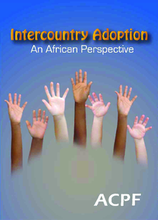This publication was prepared as a background document to inform the discussions and debates during the Fifth International Policy Conference on the African Child held on 29-30 May 2012 in Addis Ababa, Ethiopia. This report examines the rationale behind increasing intercountry adoption in Africa, the main thrust of international standards, extent and magnitude of African intercountry adoption and its problems and challenges. The paper provides recommendations to this increasing trend and aims to establish a more Pan-African position on the topic of intercountry adoption.
The report discusses the two major international standards, the Convention on the Rights of the Child and the 1993 Hague Convention, as instruments to protect children and cooperation in respect of intercountry adoption. Furthermore, the report observes the rapid growth of intercountry adoption in Africa and identifies potential problems and challenges in tackling intercountry adoption such as pressure from adoptive countries, pressure from potential financial gains, disregard for the role of traditional coping mechanisms, privatization of alternative care, independent adoptions that can be a potential for illicit practices, and inadequate government oversight as.
The report recommends that States must closely assess and scrutinize the need for and the role of intercountry adoption as a child protection measure in their country, against the principle of the best interests of the child, before embarking on the practice. For countries that allow intercountry adoption, it recommends that States must ensures that the system should ensure that the principle of the best interests of the child is the paramount consideration and is based on finding a suitable family for a child as opposed to finding a child for a family. The report recommends that treaty bodies such as the UN Committee on the Rights of the Child and the African Committee of Experts on the Rights and Welfare of the Child should review intercountry adoption policy and practice closely both in countries of origin and in receiving countries.

